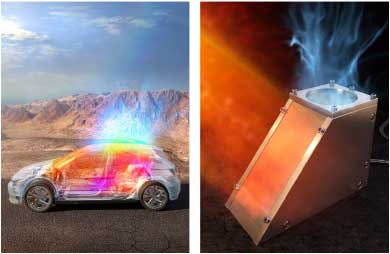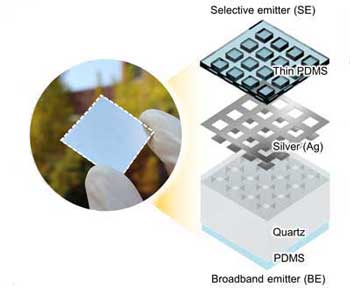| Sep 07, 2020 | |
Passive cooling of enclosed spaces |
|
| (Nanowerk Spotlight) Radiative cooling is a passive cooling strategy for lowering the temperature of an object without consuming energy or emitting pollution. These coolers are attached on exterior surfaces, rooftops, or human skin to draw heat from the periphery through conduction and convection (read more in our previous Nanowerk Spotlight on this topic: "Cooling in color"). | |
| However, this cooling method becomes ineffective when heat accumulates continuously in an enclosed space, such as a stationary vehicle exposed to direct sunlight. For instance, even under ambient temperature of only 21 °C, the inside of a parked car can heat up to 60-82 °C. Basically what happens here is that the inside of the car experiences a greenhouse effect: the windows are transparent to solar radiation coming in, while thermal infrared radiation cannot escape through them on its way out. This means heat gets trapped inside the cabin. | |
| "We hypothesized that emissivity on the inner side of a vehicle cabin could allow the trapped heat to escape by increasing the inner radiation flux, which is maximized by combining natural convection," Se-Yeon Heo, a PhD student in Prof. Song's Flexible OptoElectronics Lab at Gwangju Institute of Science and Technology, tells Nanowerk. "This means that strategic design of emission spectra on both sides of the cooler is vital for releasing the trapped heat." | |
| Heo is first author of a paper in Science Advances ("A Janus emitter for passive heat release from enclosures") where she and her coauthors propose a Janus thermal emitter that acts as a selective emitter on the top side and a broadband emitter on the bottom side. | |
| "This design effectively draws heat from an inner space and the surface, because the bottom side can absorb thermal input in a broad spectral range, while the top side emits heat into space without disturbing ambient radiation," Heo explains. | |
| As illustrated in the figure below, the Janus thermal emitter functions as an effective heat channel by using its bottom side to absorb broadband thermal radiation from the interior and its top side to radiate heat as infrared waves to the outside space as a cold sink. | |
 |
|
| Schematic diagram of heat dissipation in a thermally enclosed space with Janus thermal emitter. Left: When the Janus cooler is applied to the top of a vehicle, a bottom layer of cooler absorbs (indicated in yellow) the heat (indicated in red) inside the car and a temperature drop occurs through top layer which emits heat into the atmosphere (shown in blue). Right: Heat emission image of a model that simulates a vehicle. (Image courtesy of the researchers) | |
| The team fabricated their Janus emitter with a 4-µm-thick polydimethylsiloxane (PDMS) layer, 100-nm-thick silver layer, and 500-µm-thick micro-patterned quartz layer coated with 10-µm-thick PDMS on the bottom side. | |
| "The silver layer mostly reflects the solar spectrum and isolates the top and bottom sides in the far-IR region," Heo describes the design. "The Ag-PDMS groove causes spoof surface plasmon polariton resonance, which helps the PDMS thin-film to overcome the intrinsic emissivity loss due to the material’s abnormal extinction coefficient." | |
| For the realization of the Janus emission property it was necessary to achieve a near-ideal selective emitter. Although numerous studies have reported radiative cooling with selective emission, scaling up these designs for practical applications remains a challenge due to their complicated structures and costly nanofabrication processes. | |
| "We fabricated an optimized polymer-based near-ideal selective emitter using spoof surface plasmon polariton (sSPP)," Heo points out. "This increased the ease and affordability of building the device since polymer-based fabrication can easily be implemented by a roll-to-roll process. We optimized the design using the dispersion relation of sSPP and three-dimensional optical simulation results. Hence, this process can be considered a generalized way for obtaining scalable polymer-based selective emitters." | |
 |
|
| Inset photograph on the left shows the fabricated Janus thermal emitter exhibiting strong reflection in the visible range. On the right is a magnified structural view: From top to bottom: 4-µm PDMS, silver, micropatterned quartz, and 10-µm PDMS. (Image courtesy of the researchers) | |
| The researchers' Janus design can operate in three different modes; 1) selective emitter, 2) broadband emitter and 3) Janus emitter mode. The first two modes are the result of traditional attributes of passive radiative coolers, which target ‘surface’ cooling. | |
| For instance, the selective emitter mode can be used for building exteriors (rooftop, walls) and in power plants. The broadband emitter mode can cool heat-emitting electronic devices such as LEDs and wearable devices, which are temperature-sensitive. | |
| The Janus mode, which exhibits the novel cooling ability demonstrated in this paper, keeps the ambient temperature in an enclosed space low. This could be used for cooling enclosures where heat gets trapped, especially in stationary vehicles, enclosed solar cells and building interiors. | |
| In their experiments, the team showed that their radiative coolers achieved a ∼6 °C sub-ambient cooling effect under peak solar power of ∼680 W/m2. | |
| However, there is a disadvantage in that the cooling effect continues even in a cold environment. This is because heat from the object escapes by radiation. Therefore, in a follow-up study, the team intends to devise a radiative cooler, which maintains temperature homeostasis by turning the IR radiation on or off depending on the surrounding environment. | |
 By
Michael
Berger
– Michael is author of three books by the Royal Society of Chemistry:
Nano-Society: Pushing the Boundaries of Technology,
Nanotechnology: The Future is Tiny, and
Nanoengineering: The Skills and Tools Making Technology Invisible
Copyright ©
Nanowerk LLC
By
Michael
Berger
– Michael is author of three books by the Royal Society of Chemistry:
Nano-Society: Pushing the Boundaries of Technology,
Nanotechnology: The Future is Tiny, and
Nanoengineering: The Skills and Tools Making Technology Invisible
Copyright ©
Nanowerk LLC
|
|
|
Become a Spotlight guest author! Join our large and growing group of guest contributors. Have you just published a scientific paper or have other exciting developments to share with the nanotechnology community? Here is how to publish on nanowerk.com. |
|
